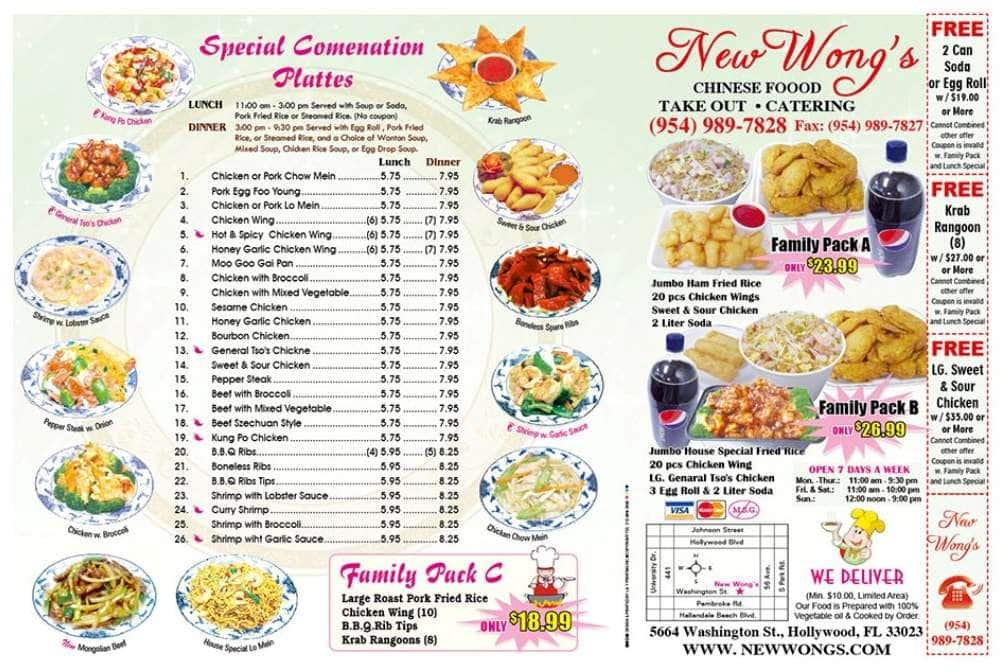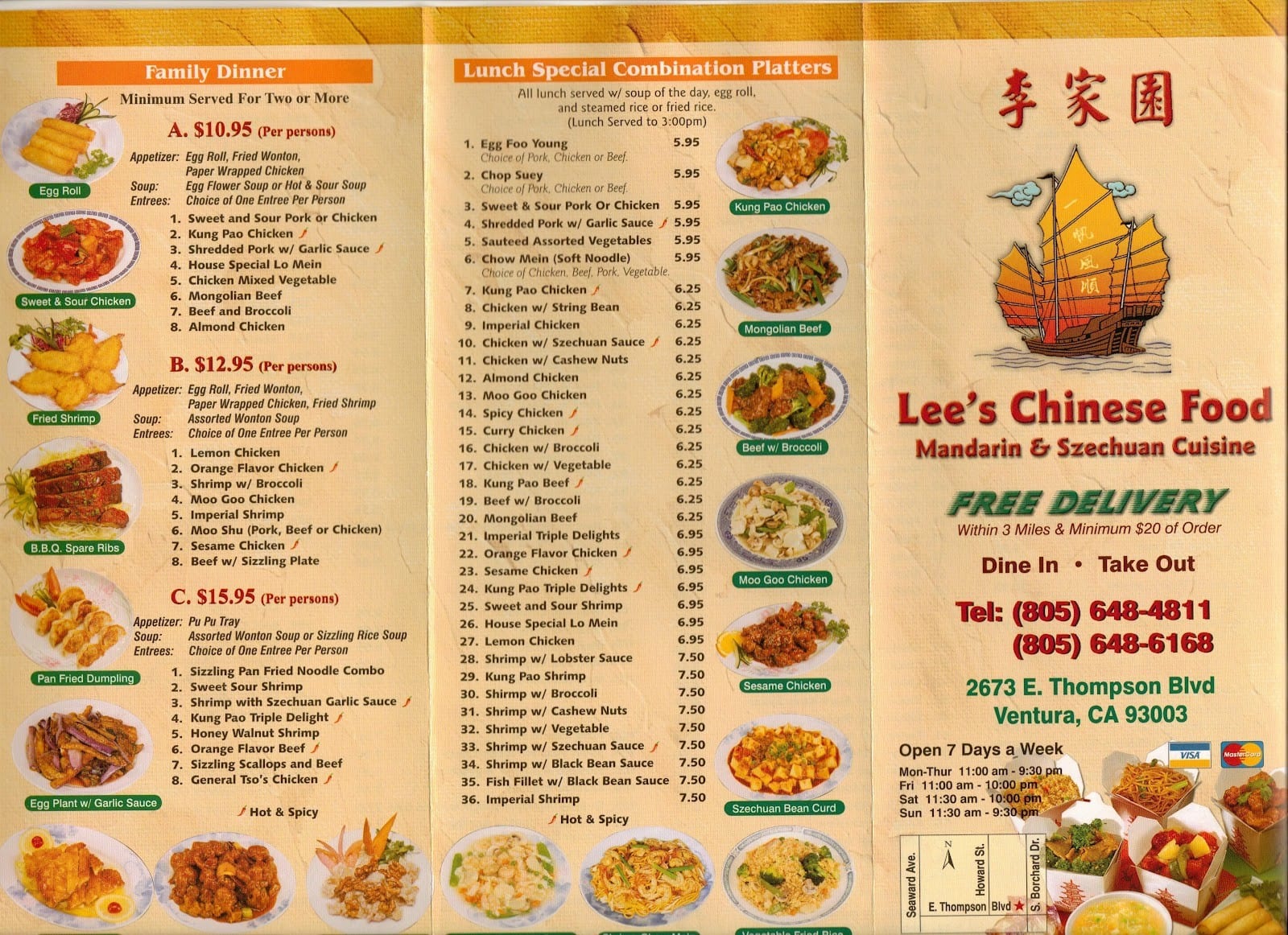Welcome to the tantalizing world of Chinese food menus, where every dish tells a story and flavors ignite the senses. Embark on a culinary journey as we delve into the structure, categories, and cultural influences that shape these delectable guides.
From the vibrant street food markets to the elegant dining halls, Chinese food menus have evolved over centuries, reflecting the rich tapestry of Chinese cuisine. Let’s explore the secrets behind these culinary roadmaps and discover the art of creating a menu that tantalizes taste buds and leaves a lasting impression.
Overview of Chinese Food Menu

A Chinese food menu is a comprehensive list of dishes and beverages offered by a Chinese restaurant. It typically includes a wide variety of options, from traditional dishes to modern creations.
Chinese food menus are typically organized into categories and subcategories. The most common categories include appetizers, soups, main courses, and desserts. Main courses are further divided into subcategories such as meat dishes, seafood dishes, and vegetarian dishes.
Use of Categories and Subcategories
The use of categories and subcategories in a Chinese food menu helps customers easily find the dishes they are looking for. It also allows restaurants to showcase their specialties and highlight their most popular dishes.
Common Dish Categories
Chinese food menus offer a wide range of dishes, organized into various categories based on cooking methods, ingredients, and regional variations. Here are the most common dish categories found on Chinese food menus:
Appetizers
Appetizers are small dishes served before the main meal to stimulate the appetite. They can include a variety of options such as spring rolls, dumplings, and soups.
Main Courses, Chinese food menu
Main courses are the centerpiece of a Chinese meal and can include a wide range of dishes. Some common examples include stir-fries, noodles, rice dishes, and soups.
Sides
Side dishes are served alongside main courses and can include a variety of options such as steamed vegetables, rice, and noodles.
Desserts
Desserts are typically sweet dishes served at the end of a meal. Some common examples include sweet soups, fruit platters, and pastries.
Variations in Dish Categories
The categories of dishes found on Chinese food menus can vary depending on the region of China. For example, Cantonese cuisine is known for its use of fresh seafood and light sauces, while Szechuan cuisine is known for its spicy dishes.
Menu Item Descriptions
Clear and concise menu item descriptions are crucial for any Chinese food menu. They entice customers, set expectations, and help them make informed choices. Effective descriptions should be accurate, engaging, and descriptive, providing customers with a clear understanding of what they are ordering.
Tips for Writing Effective Menu Item Descriptions
- Use sensory language:Appeal to the senses by using words that evoke taste, smell, sight, touch, and sound. For example, instead of “Fried Rice,” try “Golden-fried rice, bursting with savory aromas and a delightful crunch.”
- Be specific:Avoid vague or generic terms. Describe the ingredients, cooking methods, and flavors in detail.
For example, instead of “Beef Stir-fry,” try “Sizzling beef stir-fry with tender slices of beef, crisp bell peppers, and a tangy ginger-soy sauce.”
- Keep it concise:Descriptions should be informative but not overwhelming. Aim for 2-3 sentences that highlight the key features and benefits of the dish.
- Use imagery:Create a mental picture for customers by using descriptive words and phrases. For example, instead of “Steamed Dumplings,” try “Pillowy-soft steamed dumplings, filled with a juicy pork and vegetable filling.”
- Proofread carefully:Ensure descriptions are grammatically correct, free of typos, and consistent in style and tone.
Sensory Language and Imagery in Menu Descriptions
Sensory language and imagery play a powerful role in menu descriptions. By using words that appeal to the senses, you can create a vivid and memorable experience for customers. For example, using terms like “succulent,” “fragrant,” “crunchy,” and “savory” can evoke a sense of anticipation and desire.
“Aromatic stir-fry with tender chicken, vibrant vegetables, and a rich, savory sauce that dances on your taste buds.”
Pricing and Value
Pricing is a crucial aspect of Chinese food menus, influencing both customer perception and profitability. Understanding the pricing strategies and factors that determine dish prices is essential for creating a menu that provides value to customers.
Factors Influencing Dish Prices
- Ingredient Costs:The quality and quantity of ingredients used directly impact the cost of a dish.
- Labor Costs:The time and effort required to prepare a dish also contribute to its price.
- Market Demand:Popular dishes with high demand can command higher prices.
- Competition:Prices may be adjusted based on the competitive landscape and pricing of similar dishes at other restaurants.
- Restaurant Location:Restaurants in high-rent areas may charge higher prices to cover overhead costs.
Visual Appeal and Design: Chinese Food Menu
The visual appeal of a Chinese food menu plays a significant role in enticing customers and setting the tone for their dining experience. Effective menu design involves a harmonious blend of colors, fonts, and images that not only enhances the aesthetic appeal but also guides diners through the menu’s offerings in a clear and engaging manner.
Colors
The colors used in a Chinese food menu should reflect the cuisine’s vibrant and diverse nature. Red, a color often associated with good luck and prosperity in Chinese culture, is a popular choice for menu covers and backgrounds. Bold hues like yellow, orange, and green add energy and vibrancy, evoking the fresh and flavorful ingredients commonly found in Chinese dishes.
Fonts
The choice of fonts should complement the menu’s overall design and create a cohesive visual experience. Clear, easy-to-read fonts, such as Helvetica or Arial, ensure that menu items are easily identifiable, especially from a distance. For a more authentic touch, Chinese characters or calligraphic fonts can be incorporated to add a touch of cultural flair.
Images
High-quality food photography can greatly enhance the visual appeal of a Chinese food menu. Well-composed images that showcase the dishes’ vibrant colors, textures, and presentation entice diners and create a sense of anticipation. Consider using images that capture the authentic ambiance of a Chinese dining experience, such as bustling street scenes or traditional tea ceremonies.
Cultural Influences

Chinese food menus are heavily influenced by a myriad of cultural factors. These factors include regional traditions, dietary restrictions, and social customs, which all play a significant role in shaping the design and content of these menus.
For instance, in northern China, where the climate is colder, menus often feature hearty dishes such as dumplings, noodles, and soups. In contrast, in southern China, where the climate is warmer, menus tend to include more fresh vegetables, seafood, and rice dishes.
Dietary Restrictions
Dietary restrictions also have a significant impact on Chinese food menus. For example, many Chinese people are lactose intolerant, so menus often do not include dairy products. Additionally, some Chinese people are vegetarian or vegan, so menus often include a variety of plant-based dishes.
The Chinese food menu is extensive and delicious, but sometimes you just need a late-night snack. If you’re looking for late night food near me , there are plenty of options to choose from. From pizza to burgers to tacos, there’s something for everyone.
And if you’re in the mood for something a little more substantial, there are also plenty of Chinese restaurants that are open late.
Social Customs
Social customs also play a role in shaping Chinese food menus. For example, it is customary in China to share food with others, so menus often include dishes that are served family-style. Additionally, many Chinese people believe that certain foods bring good luck or fortune, so menus often include dishes that are associated with these beliefs.
Online Ordering and Menu Optimization

In today’s digital age, online ordering has become an indispensable aspect of the restaurant industry, and Chinese restaurants are no exception. Customers now expect the convenience of being able to order their favorite dishes from the comfort of their own homes or on the go.
However, optimizing Chinese food menus for online ordering presents unique challenges and opportunities. The sheer variety and complexity of Chinese cuisine can make it difficult to create online menus that are both user-friendly and effective.
Tips for Creating Effective Online Menus
- Keep it concise:Online menus should be easy to navigate and quickly scan. Avoid overwhelming customers with too many options or unnecessary details.
- Use clear and descriptive language:Ensure that dish descriptions are accurate, informative, and easy to understand. Avoid using vague or technical terms that may not be familiar to all customers.
- Categorize dishes logically:Organize your menu into clear categories, such as appetizers, entrees, and sides. This makes it easier for customers to find what they are looking for.
- Use high-quality images:Appetizing images can help customers visualize the dishes and make informed choices. Use professional photography or high-quality stock images to showcase your menu items.
- Highlight popular items:Use a separate section or visual cues to draw attention to your most popular or recommended dishes. This can help customers make quick and informed decisions.
- Offer customization options:Allow customers to customize their orders by providing options for spice level, dietary restrictions, or special requests. This flexibility enhances the customer experience and increases satisfaction.
- Optimize for mobile devices:Ensure that your online menu is mobile-friendly and easy to use on smartphones and tablets. Consider using responsive design or creating a dedicated mobile app.
Final Thoughts
As we conclude our exploration of Chinese food menus, remember that they are not mere lists of dishes but culinary masterpieces that connect diners with the vibrant flavors and traditions of Chinese cuisine. Whether you’re a seasoned connoisseur or a curious newcomer, may this guide serve as your compass, guiding you through the delectable labyrinth of Chinese culinary delights.


